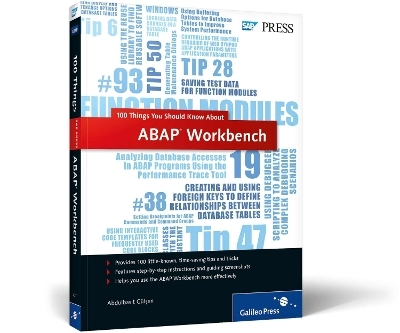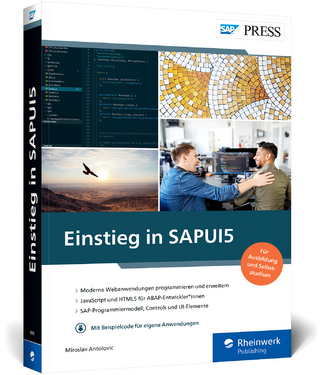
100 Things You Should Know About the ABAP Workbench
SAP Press (Verlag)
978-1-59229-427-5 (ISBN)
- Titel ist leider vergriffen;
keine Neuauflage - Artikel merken
Abdulbasit Gulsen is a senior SAP technology consultant focusing on both the ABAP and Java application environments of SAP. He started his career working as a software developer for an SAP customer. He moved to an SAP partner to work as a consultant after 2 years and has continued working as a technology consultant for 10 years. He has ABAP development experience on several platforms (SAP ECC, SAP CRM, HR, IS-U) and in diverse industries, as well as experience in other SAP platforms and tools, such as SAP NetWeaver BPM, Portal, and Web Dynpro ABAP/Java. He has been certified in the ABAP Workbench, SAP NetWeaver Portal development, and SAP NetWeaver Portal administration. Abdulbasit is also an active contributor on the SAP Community Network (SCN) and organizes local SAP community events in Turkey. In early 2012, he was selected as an SAP Mentor based on his contributions to the SAP community.
Acknowledgments. 11
Introduction. 13
PART 1. Object Navigator. 15
1. Building Package Hierarchies to Organize Development Objects. 17
2. Using the Reuse Library to Find Reusable Software Objects, Documentation, and Examples. 21
3. Accessing Your Previous Navigation Steps with the Navigation Stack. 25
4. Inserting Statement Patterns in ABAP Programs with Drag and Drop. 28
5. Using Worklists to Group Development Objects. 31
6. Managing Your Frequently Used Objects with a Favorites List. 33
7. Comparing ABAP Programs between Two Systems. 36
8. Modifying and Testing Programs with Inactive Versions of Development Objects. 39
9. Creating Local Objects for Test Purposes. 43
10. Creating and Accessing Documentation for Development Objects. 45
11. Reserving Namespaces with SAP for Third-Party Objects. 48
12. Using the Application Hierarchy Tool to Organize Applications. 50
13. Searching for Objects in Transport Requests with Transport Organizer Tools. 52
14. Searching for Development Objects using the Repository Information System. 55
15. Using OO Transactions to Link Class Methods to Transaction Codes. 58
16. Using Forward Navigation to Create Objects. 61
17. Uploading/Downloading User-Specific Settings to a Different System. 63
18. Using Package Interfaces to Create a Set of Visible Development Objects. 65
PART 2. ABAP Editor. 69
19. Comparing ABAP Programs with the Splitscreen Editor. 70
20. Viewing and Modifying Two Parts of the Same Code at Once. 73
21. Using Interactive Code Templates for Frequently Used Code Blocks. 75
22. Using Enhanced Copy and Paste Functionalities. 79
23. Searching in Real Time with Incremental Search. 81
24. Using Improved Navigation Features in the ABAP Editor. 83
25. Creating Custom Statement Patterns. 86
26. Formatting Source Code with Pretty Printer. 89
27. Using Code Hints as Prompts When Writing Code. 91
28. Using Code Completion to Complete Statements. 94
PART 3. Function Builder. 97
29. Saving Test Data for Function Modules. 98
30. Running Function Modules Successively with Test Sequences. 100
31. Creating and Using Remote-Enabled Function Modules. 102
32. Using Predefined RFC Destination BACK to Call Function Modules. 105
PART 4. Class Builder. 107
33. Maintaining Classes with the Source Code-Based Class Builder. 108
34. Renaming Methods of Classes Consistently with the Refactoring Assistant. 111
35. Using Persistent Classes to Access Database Tables. 114
36. Managing Exceptions with Exception Classes. 117
PART 5. ABAP Debugger. 121
37. Using SAP GUI Shortcuts to Debug Popup Windows. 123
38. Debugging Background Jobs. 126
39. Setting Breakpoints for ABAP Commands and Command Groups. 129
40. Using External Breakpoints to Debug External Calls. 132
41. Customizing the ABAP Debugger Desktop Tabs. 134
42. Using the Diff Tool to Compare Complex ABAP Data Structures. 138
43. Viewing and Manipulating Internal Tables Using the Table Tool. 141
44. Saving Test Data for Function Modules in the ABAP Debugger. 144
45. Using Watchpoints to Monitor Variable Changes. 146
46. Using Debugger Scripting to Analyze Complex Debugging Scenarios. 150
47. Debugging Specific Program Areas Using the Software Layer-Aware Debugger. 154
48. Using Conditional Breakpoints to Check Specific Conditions. 159
49. Using Forward Navigation Features in the ABAP Debugger. 162
50. Analyzing Deep Nested Objects in the Main Object. 165
PART 6. Analysis Tools. 169
51. Performing Detailed Checks on ABAP Programs with Extended Program Check. 170
52. Checking ABAP Programs for Naming Conventions with the Code Inspector. 174
53. Testing and Improving the Quality of ABAP Programs with Unit Tests. 178
54. Using the ABAP Runtime Analysis to Measure the Performance of an ABAP Program. 180
55. Using Checkpoint Groups to Activate and Deactivate Checkpoints. 183
56. Analyzing the Memory Consumption of ABAP Programs. 187
57. Analyzing Database Accesses in ABAP Programs Using the Performance Trace Tool. 190
58. Finding the Right Event to Trigger a Workflow. 194
59. Using the Work Item Selection Tool to Analyze Workflow Logs. 197
PART 7. ABAP Data Dictionary. 201
60. Configuring Display and Maintenance Options for Database Tables. 203
61. Generating Table Maintenance Dialogs for Database Tables or Views. 205
62. Creating and Using Foreign Keys to Define Relationships between Database Tables. 208
63. Using Foreign-Key Relationships to Create Maintenance Views. 212
64. Assigning Value Tables to Domains to Propose Foreign Keys for Database Fields. 215
65. Adjusting Screen Elements with Conversion Routines. 218
66. Creating a Secondary Index to Improve Table Access Performance. 221
67. Extending Table Maintenance Dialogs with Events. 225
68. Creating View Clusters to Group Maintenance Dialogs Together for Better Maintenance. 228
69. Using Delivery Classes to Control the Transport Behavior of the Database Table Data. 232
70. Displaying and Analyzing Table Relationships in a Graphic. 235
71. Logging Data Changes in a Database Table. 238
72. Linking Text Tables to Main Tables to Use Multi-Language Applications. 241
73. Using Buffering Options for Database Tables to Improve System Performance. 244
74. Using Lock Objects to Control Multi-User Access to Table Records. 248
75. Creating Alternative Search Help Paths with Collective Search Helps. 251
76. Using Domains to Define Value Ranges for Database Tables and Structure Components. 254
77. Attaching Search Helps Directly to Data Elements for Global Availability. 257
78. Adding Date Fields to Make Time-Sensitive Table Maintenance Dialogs. 259
79. Using the Database Utility to Transfer Structural Changes to the Database System. 262
80. Defining Ranges Using Range Table Types. 265
81. Using the Data Modeler to Create Data Models According to the SAP SERM Method. 267
PART 8. Enhancements. 271
82. Enhancing Standard Objects with Implicit Enhancement Options. 273
83. Creating Composite Enhancement Implementations to Group Enhancement Implementations Hierarchically. 277
84. Using Nested Enhancements in Existing Enhancement Implementations. 280
85. Using Enhancements When Modifying Standard ABAP Programs. 283
86. Activating or Deactivating Enhancements with the Switch Framework. 285
87. Adjusting Enhanced Objects When Upgrading the SAP System. 288
88. Using the Enhancement Category to Restrict Table and Structure Enhancements. 290
89. Creating Multiple-Use Business Add-Ins. 293
90. Using Filters to Select Between Multiple BAdI Implementations. 296
91. Finding BAdIs in SAP Transactions Using the ABAP Debugger. 299
92. Creating Customized Transactions with Transaction Variants. 302
93. Using Parameter Transactions to Create a Transaction for Table Maintenance Dialogs. 306
94. Using SET/GET Parameters to Assign Default Values for Screen Elements. 308
PART 9. Web Dynpro ABAP. 313
95. Controlling the Runtime Behavior of Web Dynpro ABAP Applications with Application Parameters. 314
96. Tailoring Web Dynpro ABAP Applications to User Groups with Application and Component Configuration. 317
97. Customizing Logon Screens for Web Dynpro ABAP Applications. 321
98. Enhancing Web Dynpro ABAP Applications in the Enhancement Framework. 325
99. Debugging Web Dynpro-Specific Program Entities. 328
100. Assigning a Transaction Code to a Web Dynpro Application Using a Parameter Transaction. 330
The Author. 333
Index. 335
| Erscheint lt. Verlag | 30.8.2012 |
|---|---|
| Reihe/Serie | SAP Press |
| Zusatzinfo | Illustrations |
| Verlagsort | Maryland |
| Sprache | englisch |
| Maße | 175 x 228 mm |
| Themenwelt | Mathematik / Informatik ► Informatik ► Netzwerke |
| Mathematik / Informatik ► Informatik ► Programmiersprachen / -werkzeuge | |
| Informatik ► Weitere Themen ► SAP | |
| Schlagworte | ABAP • ABAP Debugger • ABAP Dictionary • ABAP editor • ABAP Workbench • Object Navigator • Web Dynpro ABAP |
| ISBN-10 | 1-59229-427-8 / 1592294278 |
| ISBN-13 | 978-1-59229-427-5 / 9781592294275 |
| Zustand | Neuware |
| Informationen gemäß Produktsicherheitsverordnung (GPSR) | |
| Haben Sie eine Frage zum Produkt? |
aus dem Bereich


